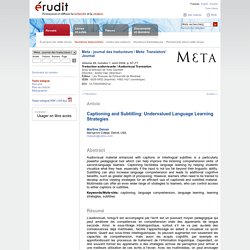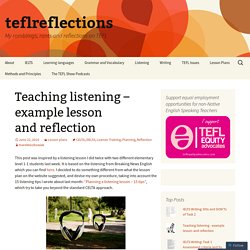

ELLLO Selected sound files. Selected sound files. Songs for listening activities. How English sounds to non-English speakers. Student Instructions For How They Can Create A Cloze (Gap-Fill) I use clozes often – both with English Language Learners and with proficient English speakers.

They’re excellent formative assessments of vocabulary comprehension and can promote metacognition if combined, as I always do, with pushing students to identify the “clue words” they use to fill-in the blanks. Clozes can come in many forms, including like the one in the photo at the top of this post. It’s also an option to put a “word bank” of answers at the top or bottom of the cloze, along with putting the first letters of each answer at the beginning of each blank, putting a blank for each letter as another form of clue, and the list of possibilities goes on-and-on.
In my opinion, the absolute best use of clozes is having students create their own after they develop enough experience completing teacher-provided ones. They then teach the clozes to their classmates, including first reading it aloud to them. • Copy and paste the original passage onto a Word document and cite the author. Related. Captioning and Subtitling: Undervalued Language Learning Strategies.
In countries where viewers rarely watch subtitled programs, for example in the United States, language students often experience feelings of guilt or annoyance when first exposed to subtitles, while language teachers themselves tend to be openly hostile to their use.

In such cases, subtitles are most commonly viewed as distracting: They are accused of encouraging viewers to rely on the written text, taking attention away from the actual spoken language, and even fostering a form of laziness bordering on cheating. Yet, many Europeans claim to have learned English from their regular exposure to subtitled American films and television programs. So how much of this learning can be attributed to the help of subtitles, and should greater effort be made to encourage the use of subtitled audiovisual material to foster second – or foreign-language acquisition in and outside the classroom? 1. Benefits and Limitations of Audiovisual Material 2. 3. 4. 5. 6.
Amara - Caption, translate, subtitle and transcribe video. Teaching EFL Learners Shadowing for Listening: Developing learners' bottom-up skills (Hardback) About the Book Shadowing, an active and highly cognitive technique for EFL listening skill development, in which learners track heard speech and vocalize it simultaneously, is gradually becoming recognized.

However, there remain a lot of mysteries and misunderstandings about it. This book uncovers shadowing in terms of theory and practice. This book cements shadowing as a separate technique from other similar techniques such as Elicited Imitation, Mirroring, and simple repetition, and provides ample empirical data to explain the function of Shadowing. It also elaborates on how Shadowing should be used in terms of materials, procedure, and learners’ psychology, which would aid in instructors’ use of Shadowing in teaching.
Teaching listening – example lesson and reflection. This post was inspired by a listening lesson I did twice with two different elementary level 1-1 students last week.

It is based on the listening from Breaking News English which you can find here. I decided to do something different from what the lesson plan on the website suggested, and devise my own procedure, taking into account the 15 listening tips I wrote about last month: “Planning a listening lesson – 15 tips”, which try to take you beyond the standard CELTA approach. First, please read through the lesson plan below and identify which of the 15 listening tips I used when designing the lesson procedure. Afterwards, you can check with my comments and reflections below the lesson plan. Lesson procedure Lead-in: Are you enjoying the World Cup? Listening for gist: Don’t worry about understanding every single word. Speaking: Do you share the speaker’s opinion? Relistening: What was difficult about the first listening? What new information did you learn after the second listening?
Homework: Listening and Speaking in Young Learner Classes.